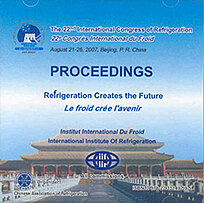
Document IIF
Conception du système de refroidissement régulé de 300 à 80 K dans l'équipement cryogénique d'appoint utilisé sur le terrain.
Design of the controlled cooling system of 300-80 K in the cryogenic ground support equipment system.
Auteurs : CHEN S. J., WANG R. S., SHI Y. M.
Résumé
The function of the cryogenic ground support equipment (CGSE) system is to cool down the AMS-02 magnet and to fill the magnetic Dewar of AMS-02 detector with He II. The controlled cooling system of 300-80 K is an important subsystem in CGSE system. Its main function is to cool down the magnet of AMS-02 from 300 to near 80 K. The magnet obviously suffers heat expansion and cold shrink when it is cooled from 300 to 80 K. In addition, the high-pure medium is to be used in the system. Therefore, the controlled cooling system of 300-80 K is designed in detail. The cooling process should be uniform and the maximal temperature difference during the cooling process is no more than 50 K. These requirements can be attained by the adjustable cryostat. The structures and characteristics of the main components and the composing of the system are also presented. Heat exchanger 1 is a cryogenic gas heat exchanger which can eliminate stress automatically and prevent its medium from being polluted. Heat exchanger 3 is a cryogenic boiling heat exchanger which can automatically complement liquid and make the liquid level steady.
Documents disponibles
Format PDF
Pages : ICR07-A1-458
Disponible
Prix public
20 €
Prix membre*
Gratuit
* meilleur tarif applicable selon le type d'adhésion (voir le détail des avantages des adhésions individuelles et collectives)
Détails
- Titre original : Design of the controlled cooling system of 300-80 K in the cryogenic ground support equipment system.
- Identifiant de la fiche : 2007-2421
- Langues : Anglais
- Source : ICR 2007. Refrigeration Creates the Future. Proceedings of the 22nd IIR International Congress of Refrigeration.
- Date d'édition : 21/08/2007
Liens
Voir d'autres communications du même compte rendu (839)
Voir le compte rendu de la conférence
Indexation
-
Konzeption der kryogenen Pumpstrecke im Experim...
- Auteurs : PUTSELYK S., GROHMANN S., KAZACHENKO O., et al.
- Date : 21/11/2007
- Langues : Allemand
- Source : DKV-Tagungsbericht 2007, Hannover.
Voir la fiche
-
Design of a cryostat for superconducting coil t...
- Auteurs : GUPTA N. C., JADHAV P. S., SARKAR B., et al.
- Date : 22/07/2002
- Langues : Anglais
- Source : Proceedings of the nineteenth International Cryogenic Engineering Conference. ICEC 19.
Voir la fiche
-
Development of full-scale prototype cryostat of...
- Auteurs : KIMURA N., OKAMURA T., SASAKI K., et al.
- Date : 17/07/2006
- Langues : Anglais
- Source : Multiconference CryoPrague 2006 (9th Cryogenics 2006, ICEC 21, ICMC'06)
- Formats : PDF
Voir la fiche
-
Forced flow helium II cooling for superconducti...
- Auteurs : SCIVER S. W. van
- Date : 05/1998
- Langues : Anglais
Voir la fiche
-
Large (250 m3) helium gas storage tank.
- Auteurs : JIRASEK P., CHRZ V., KRIVAN J., BARRANCO-LUQUE M., BOYER L.
- Date : 12/05/1998
- Langues : Anglais
- Source : Cryogenics '98. Proceedings of the Fifth Cryogenics Conference.
- Formats : PDF
Voir la fiche
